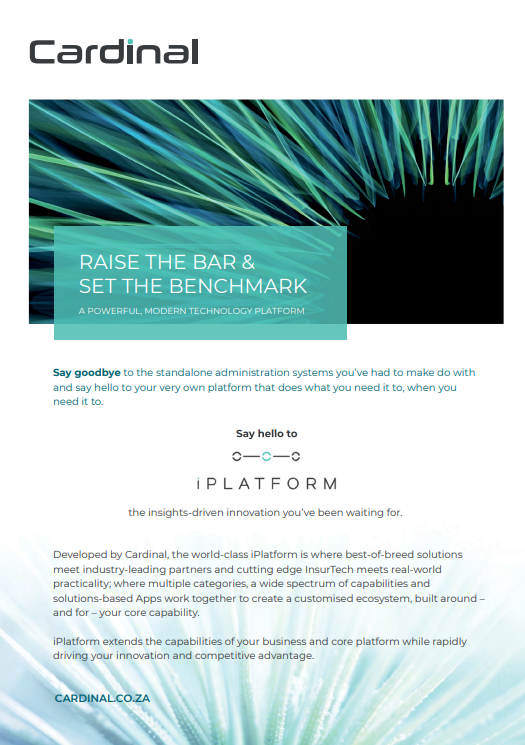Devan Reddy, Group Digital and Operations Officer, Cardinal

Over the years, technology has advanced and presented many opportunities for growth and transformation in the insurance space, leading many to predict the imminent ‘end’ of the broker. But not Cardinal. We have seen first-hand how brokers have embraced InsurTech and used it to their advantage.
As one of the leading insurance management software providers in the South African market, we have taken our own business through a transformation process over the past three years. This has been in preparation for what digital transformation is and will demand from the industry, as well as from software providers.
Through our journey, we aimed to answer the same questions brokers were asking and incorporate what we were hearing from the market and what was happening in the industry into our product innovation, design thinking and problem solving.
What we have heard repeatedly and what we know, is that everyone is becoming more digitally savvy and if you don’t keep up with technological advancements and offer your existing and prospective insurance clients digital-first solutions, there is a good chance you will lose your connection with your client. That being said, it is not necessarily implying that we are going to face the demise of the broker.
While the problems that need to be solved remain the same regardless of the size of your business, the complexity of the problem is based on the maturity of the business. When we design our solutions, we know that not every broker or UMA, or insurer, is sitting at the same level of maturity from a digital transformation point of view. We identify the lowest common denominator that appeals to all of them and work our way from that to the more niche type products and services that we build into our platform.
As you look to solve challenges within your own business, keep in mind that not every solution on the market is going to work for every business. And if a provider doesn’t ask the right questions and doesn’t establish what it is that you need, it can become a costly exercise of just adopting technology for the sake of being compliant with what you think the industry is doing.
Our experience, in the last three years, have shown the omnichannel experience become a priority for businesses. When people started to adopt the individual, vertical channels, for digital transformation, the first being web, and mobile phones, often it was done in isolation of the solutions they already had in terms of the platforms, or any previous solutions they used.
This approach resulted in the vertical, multichannel experience not adding value in the long-term – instead, it increased costs and made the back-end administration a lot more complicated. For Cardinal, the omnichannel experience was a big priority and a big problem to solve. If you look at the insurance report 2021, there is a lot of valuable insight in terms of what the market is doing and the basics we need to focus on.
Cardinal has an enterprise insurance management system which is the core of our business, but to add value to the industry, the market, and the insurance organisations we service, we knew we needed to enable what we called the ‘network effect’.
The network effect refers to collaborating with different partners to bring solutions to the table that are bigger than we can offer alone, for the benefit of all players in the industry.
With delivering market value in mind, Cardinal made the decision to make our technology PAS agnostic. We know many companies are running disparate platforms, and often there can be two or three different back-end systems that have historically handled policy administration. Our front-end digital solutions work with multiple systems, meaning you don’t have to have a Cardinal C360 solution in place before using our technology platform. This makes the journey of conversion a lot simpler for clients, with the digital front-end solution now having one journey for the client and talks to two or three back-end systems.
Another aspect we considered was what is the lowest common denominator. For us, it’s the handset. What we want is to create digital transactions that can hold a conversation between a handset and a back-end system. Using technology, we can initiate and complete a full transaction, whether it’s a policy lookup, claim FNOL, full claim submission, or a conversation between WhatsApp and our back-end system. Our clients can now access a transaction at the handset level, and not have to log in to any system.
Lastly, we are solving for the ecosystem, which is critical for us to make sure that whatever we are putting into the ecosystem, gives choice to our partners and brokers. We take care of both the current and prospective clients, as well as all partner channels.
Every channel we have built is seamlessly integrated into our back-end system. With that integration, we have successfully built client journeys that provide a single point of entry.
When working with Cardinal, you don’t have to take everything that we have to offer – we have a basket of services that we have built into our platform to enable broker choices that are both cost-effective and relevant.
- For more information on our ecosystem, visit our iPlatform page.


